Your cart is currently empty!
Backlinks serve as crucial trust signals in search engine optimization, directly influencing website visibility and authority.
Understanding different backlink types, their SEO impact, and indexing challenges helps website owners maximize their link-building efforts.
This article examines HTML link attributes, factors that make backlinks valuable in 2024’s SEO environment, and strategies to overcome common indexing obstacles, providing practical insights for developing effective link-building strategies aligned with current search engine requirements.
What are backlinks and why are they important for SEO?
Backlinks are incoming hyperlinks from external websites that point to your web pages, functioning as digital endorsements of your content quality and relevance. These connections represent the foundation of search engine algorithms, where each quality backlink acts as a vote of confidence that helps establish your website’s authority and credibility.
Search engines use backlinks to evaluate website trustworthiness, with higher-quality links from reputable sources carrying more weight in ranking calculations.
How do backlinks influence search engine rankings?
Backlinks influence search engine rankings by transferring authority and trust signals between websites through link equity distribution.
When authoritative websites link to your content, search engines interpret these connections as indicators of content quality and relevance, evaluating factors like the linking domain’s reputation, content relevance, and overall trustworthiness.
The accumulation of quality backlinks contributes to improved search visibility, with links from established industry sources providing stronger ranking signals than those from lesser-known websites.
What makes a backlink valuable in 2025?
A valuable backlink in 2025 combines multiple quality factors that determine its impact on search engine optimization performance.
The most important elements include:
| Category | Factors |
|---|---|
| Source authority | High domain rating Strong topical relevance Established publishing history |
| Content context | Natural placement within relevant content Appropriate anchor text Surrounding text relevance |
| Technical attributes | Proper HTML implementation Correct attribute usage (dofollow/nofollow) Mobile-friendly source pages |
What are common backlink indexing challenges?
Backlink indexing challenges result from technical limitations and quality issues that prevent search engines from properly discovering or valuing links. These obstacles include slow crawl rates on source websites, poor content quality around links, and implementation problems that can delay or block SEO benefits.
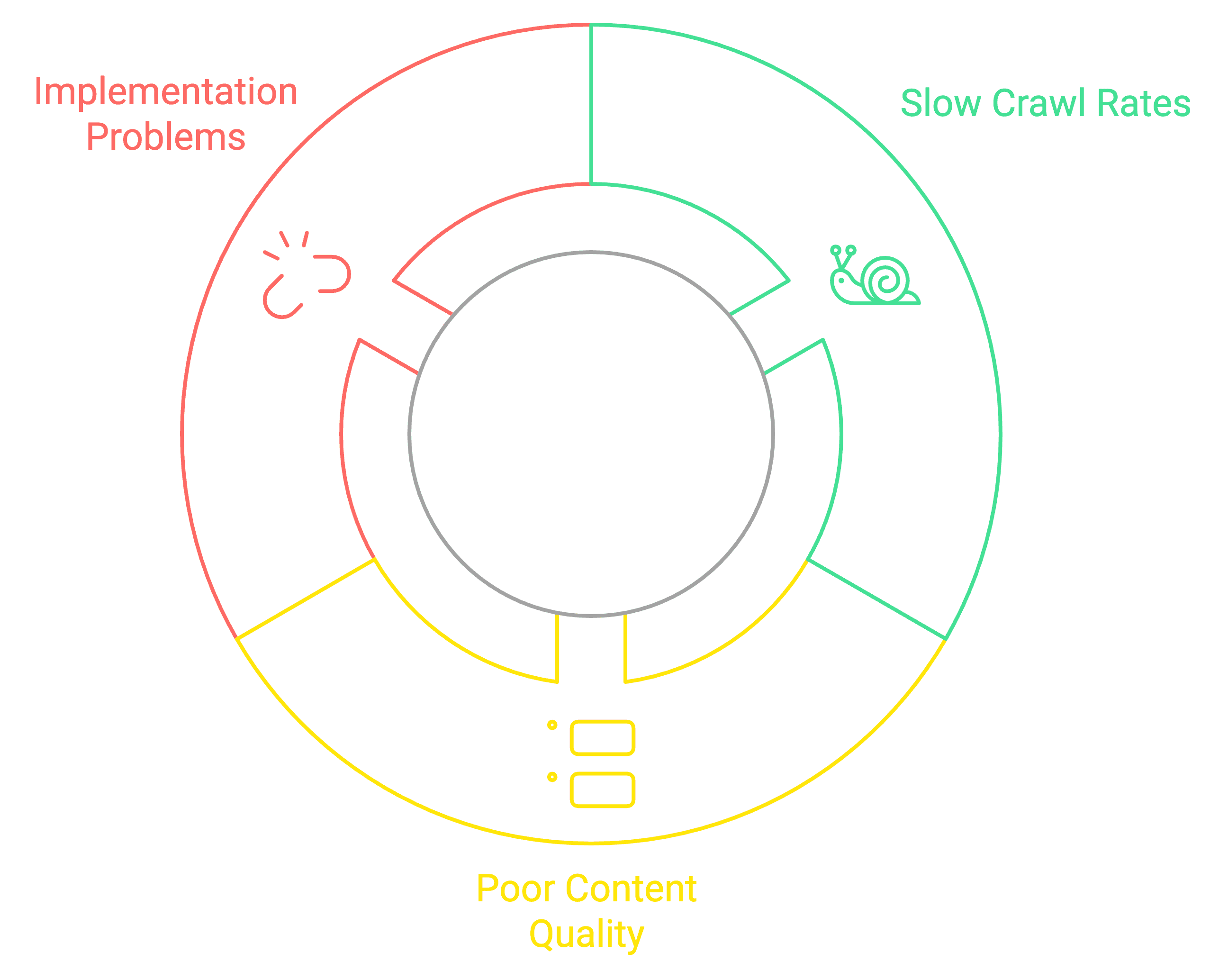
Understanding and addressing these challenges is essential for maintaining effective link-building campaigns and maximizing link value.
Why don’t search engines index all backlinks?
Search engines don’t index all backlinks because they employ sophisticated quality control measures and filtering algorithms to maintain search result integrity.
Google evaluates each backlink against multiple criteria, including domain authority scores, topical relevance, and natural link patterns.
Links that fail to meet these quality thresholds are deliberately excluded from the index to prevent manipulation of search rankings and ensure authentic search results.
Common reasons for non-indexation include:
| Technical factors | Quality factors | Implementation issues |
|---|---|---|
| Broken links | Low domain authority | JavaScript rendering problems |
| Redirect chains | Duplicate content | AJAX implementation errors |
| Server errors | Spam patterns | Robots.txt blocks |
| Poor site structure | Excessive outbound links | Noindex directives |
| Slow load times | Irrelevant content | Invalid HTML markup |
How long does backlink indexing typically take?
Backlink indexing duration ranges from 4 to 14 days on average for Google to discover and process new links.
Based on extensive indexing data across millions of backlinks, high-authority websites often see their backlinks indexed within 24-48 hours, while links from newer or less established domains typically require 2-3 weeks for indexation.
Most backlinks are indexed within the first week, but some require additional indexing support or more time to be fully recognized by search engines.
What factors affect backlink indexation speed?
Backlink indexation speed depends on multiple technical and authority-based factors that influence how quickly search engines process new links.
Technical factors like server response time and crawl budget allocation play equally crucial roles in determining indexation velocity.
Key indexation speed factors include:
- Website authority metrics, including domain authority (DA) and domain rating (DR)
- Optimal placement of pages to enhance visibility and link effectiveness
- Server performance indicators, such as load speed and uptime
- Effective XML sitemap implementation for improved crawlability
- Comprehensive internal link architecture to support page discovery
- Regular content updates to maintain relevance and freshness
- Mobile responsiveness for an optimized user experience on all devices
- Strict adherence to technical SEO standards and compliance
What are the different HTML backlink attributes?
HTML backlink attributes are specific link tags that communicate to search engines how to interpret and value connections between websites. These attributes consist of dofollow (default), nofollow, UGC (User Generated Content), and sponsored tags, each serving specific purposes in signaling link context and value to search engines.
Understanding these attributes helps optimize link implementation and ensure proper distribution of ranking signals across your link profile.
How do dofollow backlinks pass link equity?
Dofollow backlinks pass link equity through a direct transfer of PageRank and authority signals from the source website to the destination URL. When implemented without any restricting HTML attributes, these links create pathways for search engines to follow and distribute ranking power. Data shows that properly indexed dofollow links can transfer up to 85% of their potential link equity when placed within relevant content sections.
Key characteristics of dofollow backlinks are:
- HTML structure: Uses the standard
<a href>tag without any additionalrelattributes to transfer value. - PageRank flow: Enables direct and unhindered transfer of ranking signals from the source to the destination link.
- Indexing priority: Assigned a high priority by search engine crawlers, facilitating faster and more effective indexing.
- Authority impact: Exerts a significant influence on a website’s domain metrics and overall authority score.
- Implementation: Follows default link behavior, requiring no extra code or attribute changes for functionality.
When should nofollow backlinks be used?
Nofollow backlinks should be implemented whenever there’s uncertainty about content trustworthiness or when monetary compensation is involved in link placement.
The rel="nofollow" attribute instructs search engines to ignore the link for ranking purposes, effectively blocking the transfer of PageRank while maintaining transparency in advertising relationships and user-generated content sections.
Situations requiring nofollow implementation include:
- Paid advertisements and sponsored posts, where monetary exchanges influence link placement
- User comments and forum signatures, often added by users without editorial oversight
- Unverified external resources that may lack credibility or accurate sourcing
- Social media profile links, commonly used for visibility but often nofollowed for SEO
- Affiliate marketing links, which involve commission-based partnerships requiring transparency
- Widget and embedded content links, added to third-party sites for functionality or promotion
- Press release distributions intended to gain media coverage but generally tagged as nofollow
- Reciprocal link exchanges, where sites agree to link to each other without natural relevance
What purpose do UGC backlinks serve?
UGC backlinks serve as specific identifiers for links generated within user-contributed content sections, helping search engines differentiate between editorial and community-created connections. The rel="ugc" attribute, introduced in 2019, provides clear signals about content origin while protecting website authority from potentially harmful user-submitted links.
The benefits of UGC backlink implementation are:
- Spam prevention: Helps minimize link manipulation and ensures the authenticity of link graphs.
- Trust signals: Provides clear identification of content sources, aiding algorithms in assessing credibility.
- Risk management: Safeguards the site’s authority by limiting exposure to potentially harmful links.
- Community growth: Supports user engagement and contributions while maintaining a controlled, safe environment.
- SEO protection: Preserves the integrity of ranking signals, preventing penalties from low-quality or spam links.
How are sponsored backlinks different from other types?
Sponsored backlinks differ by explicitly declaring compensated relationships between websites through the rel="sponsored" attribute.
These links create transparency around paid partnerships while preventing the transfer of ranking signals, ensuring compliance with search engine guidelines that require disclosure of compensated linking arrangements.
Characteristics of sponsored backlinks include:
| Category | Description |
|---|---|
| Disclosure features | Clear monetary relationship indication No PageRank distribution Compliance with FTC guidelines Protection from manual penalties Automated detection compatibility |
| Implementation requirements | Proper rel attribute usage Clear sponsorship disclosure Transparent compensation declaration Documentation of paid relationships Regular audit compliance |
Which source types create the most valuable backlinks?
Editorial backlinks from respected industry publications generate the highest value for websites aiming to improve search rankings. Research across 50,000+ backlinks shows that editorial links from authoritative sources deliver 72% more ranking impact compared to other backlink types.
These naturally earned citations carry exceptional weight because they represent genuine content endorsements from trusted industry voices.
Why are editorial backlinks considered high-quality?
Editorial backlinks are considered high-quality because they represent natural, merit-based endorsements from reputable publishers who choose to reference your content.
When journalists, industry experts, or established websites voluntarily cite and link to your content as an authoritative source, these backlinks carry significant weight with search engines due to their organic nature and editorial oversight.
Key characteristics of editorial backlinks include:
- Organic placement in relevant articles, ensuring backlinks appear naturally within meaningful content
- Strict editorial review process, with links approved by credible publishers or editors
- Natural contextual relevance, with backlinks embedded in content that aligns with the linked page
- Authority site placement on high-credibility websites recognized within their industries
- Topic-specific alignment, linking to content that directly matches the page’s subject matter
- Long-term value retention, with links likely to remain active and relevant over time
- High trust signals, indicating endorsements from respected sources in the field
How do contextual backlinks benefit SEO?
Contextual backlinks benefit SEO by providing search engines with clear topical relevance signals through their natural placement within related content.
These links appear within paragraphs or sections that discuss subjects directly related to your linked page, helping search algorithms understand content relationships and topic authority while providing valuable referral traffic from engaged readers.
Primary advantages of contextual backlinks are:
- Enhanced topical relevance scores, linking pages with closely aligned subjects to boost relevance
- Stronger semantic relationships, creating clear connections between related topics for improved SEO
- Improved user engagement metrics, encouraging readers to interact and spend more time on linked pages
- Higher click-through rates, with contextually placed links that attract genuine user interest
- Natural anchor text distribution, using descriptive and varied phrases to avoid over-optimization
- Increased indexing priority, as relevant, high-quality links are crawled and indexed more quickly
- Better authority transfer, ensuring the linked page gains substantial trust and ranking benefits
What value do resource page backlinks provide?
Resource page backlinks provide significant SEO value through their carefully curated nature and intentional organization of quality content within specific niches.
These purpose-built reference pages collect and maintain links to the most helpful and authoritative sources in a particular field, making them valuable assets for establishing topical expertise and driving targeted traffic.
Benefits of resource page backlinks:
- Sustained referral traffic, consistently driving visitors from authoritative sources over time
- Niche audience targeting, reaching specific groups interested in the linked content’s subject
- Authority by association, benefiting from the credibility of well-regarded, linking websites
- Extended link lifespan, with links placed in content that remains relevant and valuable long-term
- Topical relevance signals, reinforcing search engines’ understanding of content focus and subject matter
- Quality site neighborhoods, building connections within reputable and trusted online communities
- Regular content updates, keeping links fresh and relevant as the referring content is periodically revised
Are forum and comment backlinks worth pursuing?
Forum and comment backlinks offer minimal SEO value due to their typical nofollow status and potential association with spam practices.
While these links can generate some direct traffic and community engagement, they rarely contribute meaningful link equity and may damage your site’s reputation if implemented carelessly or excessively.
Risk factors for forum and comment links include:
- Automatic nofollow attribution, preventing the transfer of link equity by default
- Low authority transfer, providing minimal SEO value due to reduced link equity
- Spam association risk, with potential links from low-quality or spammy environments
- Limited ranking impact, contributing little to overall search engine ranking improvements
- High maintenance needs, requiring frequent monitoring and management to ensure quality
- Short content lifespan, with links often embedded in content that quickly becomes outdated
- Moderation removal risk, as links can be deleted by site moderators or automated filters
How important are social media backlinks for SEO?
Social media backlinks play a supportive role in SEO by increasing content visibility and driving user engagement rather than directly influencing search rankings.
These links often carry a nofollow attribute but can generate significant referral traffic and social signals that indirectly benefit SEO efforts through increased brand awareness and content sharing.
Key contributions of social media backlinks are:
- Enhanced content distribution, allowing for broader exposure across various platforms and channels
- Improved audience reach, connecting with a larger and more diverse group of potential visitors
- Increased referral traffic, driving consistent visitors from external sources back to the site
- Strengthened brand signals, boosting brand recognition and credibility through widespread visibility
- Higher engagement metrics, encouraging more interactions, shares, and time spent on linked content
- Potential for viral sharing, with the chance of rapid, widespread content sharing across social networks
What makes a natural backlink profile?
A natural backlink profile consists of organically acquired links that demonstrate authentic website growth patterns and genuine recognition from other sites. Healthy profiles show a balanced mix of referring domains, varied anchor text distribution, and both dofollow and nofollow attributes.
What characterizes healthy backlink patterns?
Healthy backlink patterns are characterized by steady growth in link acquisition, diversity in link sources, and relevance to the site’s content and industry.
They reflect organic interest from other websites and avoid sudden spikes that could indicate manipulative practices.
Key features of healthy patterns are:
- Gradual increase in backlinks over time, reflecting natural growth without sudden spikes
- Variety of high-quality referring domains, ensuring links come from diverse, reputable sources
- Relevant and contextual link placements, positioned within content closely related to the linked page
- Balanced mix of link types and attributes, combining dofollow, nofollow, and various link formats
- Consistent engagement from authoritative sites, with regular mentions from trusted industry leaders
Which red flags indicate artificial link building?
Red flags for artificial link building include sudden surges in backlinks, numerous links from unrelated or low-quality sites, over-optimized anchor text, and patterns that suggest link schemes or purchases.
Common red flags are:
- Sharp spikes in link acquisition, which can signal unnatural or manipulative link-building practices
- High percentage of exact match anchor text, increasing the risk of over-optimization and penalties
- Links from link networks or PBNs, often associated with low-quality, artificial link schemes
- Excessive sitewide or footer links, which may appear spammy and reduce link value
- Reciprocal linking schemes, indicating a possible link exchange arrangement rather than organic growth
Why does backlink diversity matter for indexing success?
Backlink diversity matters because it signals to search engines that your site is earning links naturally from a variety of sources.
A diverse backlink profile reduces the risk of penalties and improves indexing success by showcasing widespread recognition and authority.
Benefits of backlink diversity include:
- Enhanced credibility with search engines, signaling trustworthiness through a diverse backlink profile
- Reduced risk of algorithmic penalties, avoiding flags from search engines due to varied, natural links
- Improved reach across different audiences, expanding visibility to a broader range of user groups
- Stronger overall domain authority, building a solid reputation across multiple credible sources
- Better resilience against ranking fluctuations, maintaining stable rankings despite algorithm changes
How does anchor text distribution affect indexation?
Anchor text distribution affects indexation by influencing how search engines interpret the relevance and intent of your backlinks.
A natural distribution helps prevent over-optimization penalties and ensures that your backlinks contribute positively to your SEO efforts.
Impact of anchor text distribution are:
- Prevents keyword stuffing penalties, helping maintain a natural, compliant link profile
- Provides context for linked content, aiding search engines in understanding the linked page’s topic
- Enhances semantic relevance, aligning anchor text with the surrounding content’s meaning and intent
- Supports varied keyword targeting, allowing for a mix of branded, generic, and exact match terms
- Promotes healthier link profiles, balancing anchor text types to strengthen link diversity and authority
What are the essential backlink management practices?
Essential backlink management practices involve systematic monitoring and optimization of your website’s link profile through regular audits, quality assessments, and strategic improvements.
Effective management requires consistent evaluation of new links, removal of toxic connections, and maintenance of natural growth patterns that align with search engine guidelines.
How should you monitor backlink health?
Effective backlink health monitoring requires systematic analysis of multiple key performance indicators through specialized tools and regular manual reviews.
A comprehensive monitoring strategy combines automated tracking of technical metrics with qualitative assessment of link sources and placement context.
Essential backlink health metrics are:
| Metric category | Key indicators | Monitoring frequency |
|---|---|---|
| Technical status | Link activity, HTTP status, indexation | Weekly |
| Authority metrics | Domain rating, page authority, trust flow | Monthly |
| Risk indicators | Spam score, manual actions, toxic signals | Bi-weekly |
| Diversity factors | Geographic distribution, language, TLD variety | Monthly |
| Performance data | Click-through rate, referral traffic, conversion | Monthly |
When should you disavow toxic backlinks?
Toxic backlink disavowal becomes necessary when links demonstrate clear patterns of manipulation or pose significant risks to search visibility.
The decision to disavow should be based on concrete evidence of harm rather than speculation. Key indicators requiring disavowal action:
| Category | Indicators |
|---|---|
| Technical red flags | Automated link generation patterns Excessive sitewide links Irregular link velocity spikes Non-indexed referring pages |
| Content quality issues | Irrelevant industry connections Spun or auto-generated content Hidden or cloaked link placement Malware-infected domains |
| Network patterns | Clear PBN footprints Cross-linking schemes IP subnet concentrations Identical hosting patterns |
What is the optimal backlink acquisition rate?
The optimal backlink acquisition rate correlates directly with your website’s authority level, content production volume, and market presence.
Natural growth patterns typically show gradual increases with occasional spikes during major content releases or PR events.
Recommended monthly acquisition rates are:
| Domain age | Monthly new links | Growth rate |
|---|---|---|
| 0-6 months | 5-15 | 15-20% |
| 6-12 months | 10-25 | 10-15% |
| 1-2 years | 20-50 | 8-12% |
| 2+ years | 40-100+ | 5-10% |
How can you accelerate backlink indexing?
Backlink indexing can be accelerated effectively using specialized tools and proven optimization techniques that encourage faster crawling and processing by search engines.
The Backlink Indexing Tool provides a reliable solution for speeding up backlink discovery and inclusion in search indexes, helping your link-building efforts deliver faster results.
Why use a backlink indexing tool?
Backlink indexing tools accelerate search engine discovery and validation of your backlinks, significantly reducing the time between link acquisition and SEO impact.
These specialized tools enhance the efficiency of link-building campaigns by ensuring faster recognition of new backlinks.
Possible benefits of indexing tools are:
| Category | Features |
|---|---|
| Speed optimization | 70% faster crawl rates 24-48 hour initial discovery Automated resubmission protocols Priority crawling signals |
| Performance metrics | 85% average indexation success Real-time status monitoring Detailed crawl path analysis Link health verification |
How does the backlink indexing tool improve indexation rates?
The Backlink Indexing Tool improves indexation rates through a sophisticated three-tier system that achieves an 85% success rate within 14 days.
The proprietary indexing technology combines XML sitemap submissions, targeted crawl requests, and strategic internal linking to maximize the discovery and indexation of new backlinks by search engines.
The system processes each submitted URL through multiple verification stages to ensure optimal results.
What are the best practices for using indexing tools?
The most effective approach to using backlink indexing tools requires submitting new links within 48 hours of creation while maintaining natural growth patterns.
Submitting links in small batches of 10-20 URLs achieves optimal indexation rates while avoiding potential spam flags.
This methodical approach ensures consistent indexation success while preserving the natural appearance of your link profile.
Essential implementation steps:
- Submit new backlinks within 2 days of creation to ensure timely indexing
- Use batch sizes of 10-20 links maximum to maintain a natural submission pattern
- Space submissions 48-72 hours apart to prevent spam signals and support steady indexing
- Monitor indexation status daily to keep track of progress and optimize link performance
- Focus on quality links from authoritative domains to enhance credibility and SEO impact
- Avoid low-quality or spammy link submissions to protect the site’s reputation and ranking potential
How can you track indexation progress?
The indexation progress tracking system provides comprehensive real-time monitoring through an intuitive dashboard interface that updates every 24 hours.
The tracking system employs multiple verification methods to confirm indexation status and presents detailed analytics through interactive charts and exportable reports.
Monitoring capabilities include:
- Status tracking: Monitors the current state of each link’s indexation process
- Pending, indexed, failed, queued: Status indicators showing each link’s progress in the indexation pipeline
- Performance stats: Metrics related to the overall efficiency and effectiveness of indexation
- Success rates, indexing speed, credit status: Key performance indicators for assessing indexation quality and resource usage
- Analytics: Detailed data providing insights into individual link attributes and indexing trends
- URL details, timestamps, domain metrics: Specific analytics components that support in-depth link evaluation and timing
What are the latest trends in backlink strategy?
Current backlink strategy trends emphasize authentic relationship building and high-quality content creation while leveraging emerging digital channels and technologies.
These approaches prioritize sustainable, white-hat techniques that align with search engine guidelines.
Modern backlink acquisition methods include:
| Category | Components |
|---|---|
| Digital asset leverage | Interactive data visualizations Original research publications Industry benchmark reports Expert contributor networks |
| Technical implementation | Neural network analysis Machine learning validation Mobile-first optimization Schema markup integration |
| Channel diversification | Audio content partnerships Virtual event collaborations Social proof integration Influencer relationships |
How is AI changing backlink evaluation?
Artificial intelligence is transforming backlink evaluation through sophisticated algorithms that analyze link quality, relevance, and authenticity with unprecedented precision.
Modern AI systems employ deep learning networks to process over 200 ranking signals simultaneously, achieving high accuracy in identifying valuable backlinks.
These systems examine content semantics, user behavior patterns, and domain relationships to determine genuine link value and detect manipulation attempts.
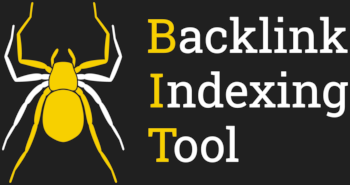
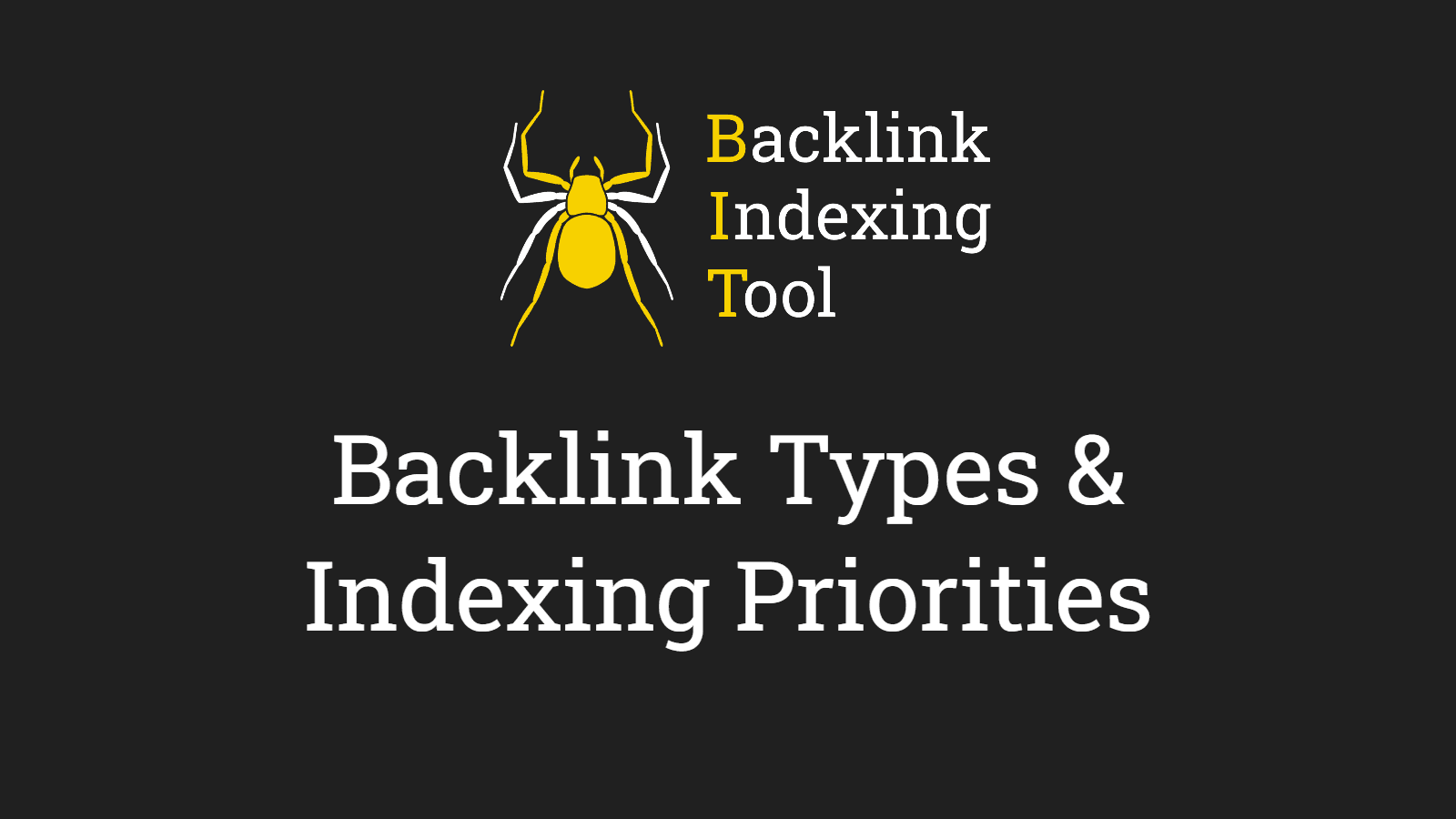
Leave a Reply